Embedded World 2023: Unity on Software, Standards Lays Foundation for Future Innovation
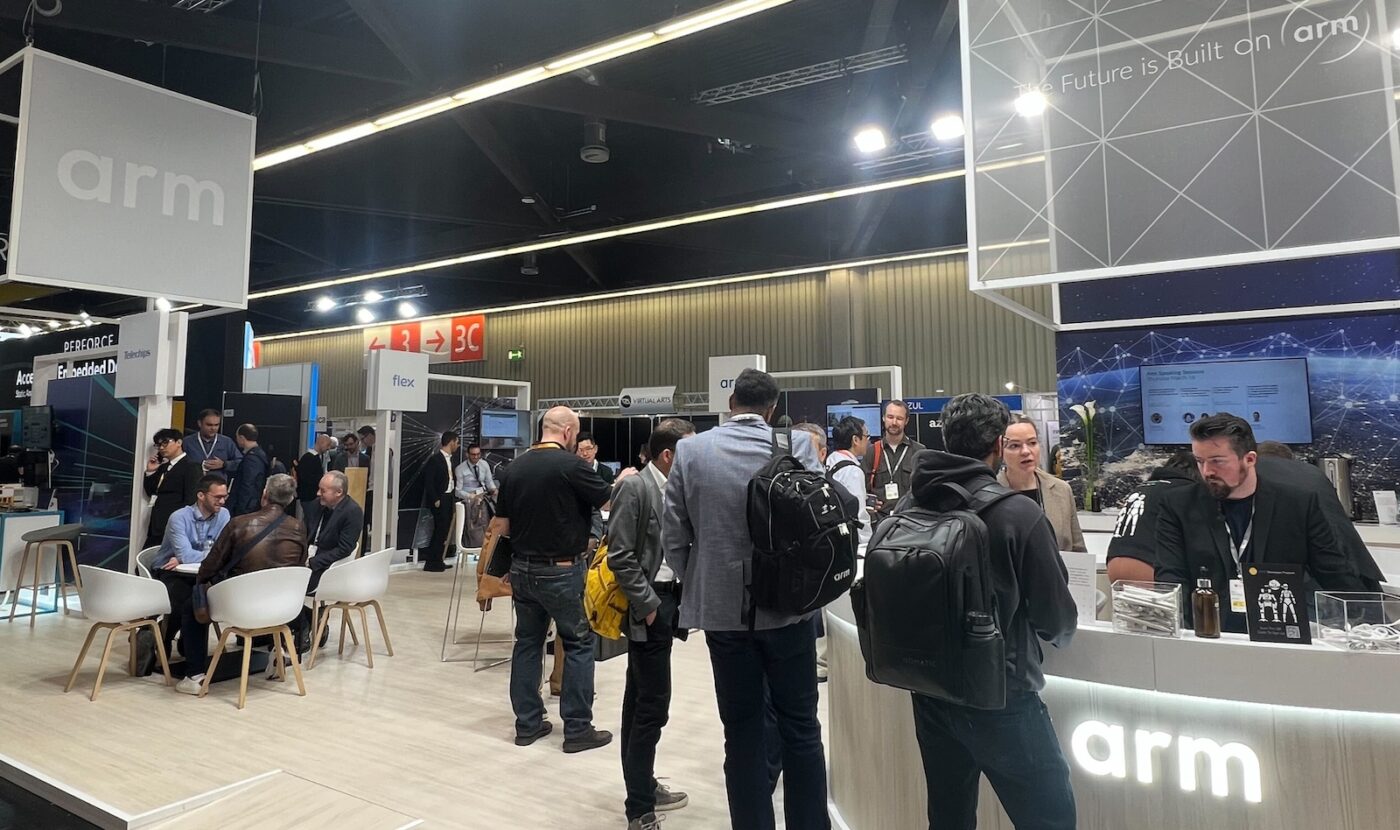
NUREMBERG, Germany – If you had to boil down three days of frenetic activity at the 2023 Embedded World here last week to one word, it would be “unity.”
Throughout the sessions, demonstrations, networking and parties that accompany a major embedded event like this, there was a unity of spirit, purpose and direction that suggests IoT and automotive have crossed a bridge toward more accelerated innovation.
Both of these vertical segments have long held promise in the context of digital transformation; however their early growth periods were marked by cautious exploration, fragmented technology and a lack of standards. Embedded World 2023 suggested that’s becoming a memory.
It was evident on the eve of the event, in the offices of SUSE in Nuremberg, where scores of people gathered to nibble on local food and sip beer and wine while discussing how the SOAFEE automotive standards effort is transforming how we develop automotive software.
Accelerating automotive
Robert Day, Arm director of automotive partnerships, and a SOAFEE governing body member, said, “When we kicked this initiative off, we said ‘this is a big thing. No one company can do it, can drive increased development innovation in automotive.’ We need to be basically a consortium of the ecosystem.”
In the 18 months since SOAFEE was formed, the group has already swelled to 80 members. The membership roll includes Woven Planet, CARIAD, AWS, SUSE, Red Hat, Continental, Bosch and more.
“We’ve done quite a good job of bringing the industry together,” Day said, gesturing around the packed room at SOAFEE members at the event, which was hosted by Elektrobit, Arm and SUSE.
In a nutshell, the driving force behind SOAFEE is the need to manage increasing complexity: The future vehicle is software-defined – enabling developers to easily create and deploy software to update vehicles and the driving experience – and the amount of code required to power the software-defined vehicle is enormous. In this context, design and development efficiency is paramount.
SOAFEE members wanted to bring some of the methodologies and some of the standards that are used in other industries over to embedded, specifically for the software-defined vehicle. Specifically, how can cloud-native methodologies be brought into the automotive ecosystem?
“SOAFEE is bringing the ability to develop in the cloud and then deploy to the vehicle,” Day said. “But the difference between cloud development for cloud and cloud development for cars is that cars need to worry about things like safety in real time. So part of this SOAFEE initiative is really looking at how we can introduce cloud technologies like orchestration and containerization into vehicles, but actually understand that this will be targeting heterogeneous compute with safety and real-time functionality.”
SOAFEE had a presence at the Arm Embedded World booth showing off demos that included one focused on SOAFEE’s automotive application-specific blueprints, contributed by members of the SIG, to showcase reference implementations of specific automotive use cases adhering to SOAFEE-defined architecture guidelines and specifications. One demo showed the Autoware autonomous software stack running on an ADLINK-developed AVA Development platform, running on an Arm-based Ampere Altra SoC.
:car:Software is defining what it means to own a car today, with initiatives like SOAFEE contributing to the software-defined future.
Ben Mordaunt talks us through the 32-core Neoverse N1 powered AVA developer platform running the SOAFEE reference implementation. #EW23 pic.twitter.com/LQTaU5NH4B
— Arm (@Arm) March 22, 2023
Propelling IoT innovation through standards
Unity was on full display in IoT as well. Reinhard Keil, Arm senior director of embedded technology, whom many view as the unofficial “chairman of the board” of the embedded world today, put it succinctly: “It’s really exciting to have people again at Embedded World to come together after so long,” he said. “And now we’re back, and, as you know, I’m looking forward to making developers more productive. This is basically the remit from the top. That’s why we did Keil tools.”
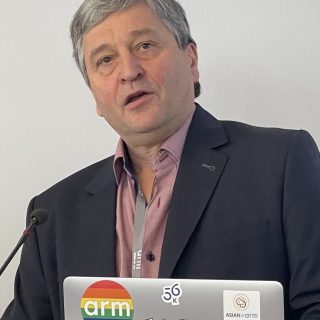
Keil (above) added, “when you see what we are doing today with GitHub, with CI integration, with the flexible IDE that is extensible and with our software components that are focusing more and more on machine learning and artificial intelligence, then you see how embedded design is being transformed.”
Chloe Ma, vice president, Arm China Go to Market, IoT and Embedded, talked about emerging unification in IoT that will overcome, among other things, a lot of consumer technology-adoption issues.
For example, Ma said she believes a lot of existing smart-home solutions are “siloed.”
“I have to use five apps to control all the light bulbs in my house,” she joked. “But there are some changes in the industry that are going to bring us the much-needed unification and interoperability.”
These include industry collaboration efforts, such as Matter, which is designed to make device interconnectivity problems a thing of the past.
“It unifies WiFi and Thread with IP protocol so that you can easily connect everything at your home without a custom gateway,” she said.
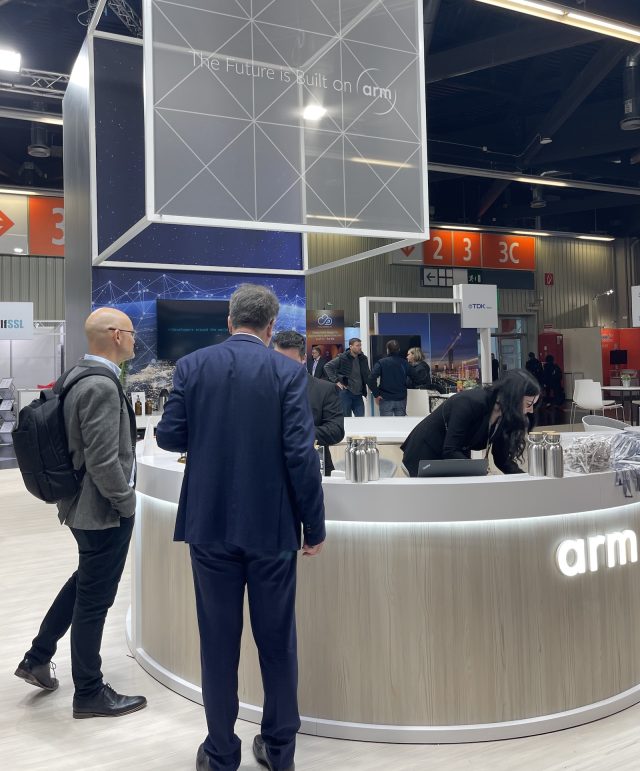
It extends to security as well. Ma said she didn’t use to care about security because if someone hacked her smart light bulb there really wasn’t anywhere further to exploit inside the home. But now with the proliferation of connected devices, security looms as an important issue.
“At Arm, we are working through an organization that we created along with like-minded people in the industry called PSA Certified to make it much easier and quicker to follow security-by-design with best practices,” she said. “And even better, we mapped the Matter security requirement to PSA Certification. So once you get PSA Certified, it’s much easier to get Matter compliance in terms of security.”
Valentin Heidelberger, senior solutions engineer with GitHub, spent much of the week in the Arm booth showing off two demos, one highlighting a project running on Arm Virtual Hardware – which virtualizes popular Arm-based processors on local hardware and in the cloud – and the other being an IoT Arm-AWS integration example. In the latter, the Arm device talked to AWS as part of an IoT implementation.
“It’s a fully integrated Arm developer experience in Visual Studio Code, using the VS Code extension Arm provides,” Heidelberger said. “So as a developer, I don’t have to leave my IDE – my VS Code anymore – to build Arm software and flash it onto the device. I can just stay in my IDE and get going.”
Heidelberger makes a small change to his project code and runs a rebuild right on his machine directly in VS Code. In an instant, the rebuild is done and the updated project is working. The other demo shows how that code snippet runs on the Arm device and connects to AWS.
“That’s basically a demo for an IoT use case including real hardware,” Heidelberger said. “We might have an Arm device somewhere on the edge talking to AWS, for example, streaming sensory data.”
The Arm developer experience extends to collaborating on code using GitHub.
“I can also push my changes and run a rebuild on GitHub, fully integrated with my software development lifecycle and automated CI/CD workflows in GitHub Actions” he said. “This is especially useful to review changes other contributors have made without having to download and build them on my local machine every time someone makes a change.”
Referencing the competition for skilled IT engineers organizations are facing, he continued, “GitHub also makes onboarding experiences much faster and smoother. I might be a new hire or have a new notebook and don’t have time to set up a ton of dependencies just to make a code change. Using GitHub Codespaces, a reproducible VS Code instance running in the cloud with all my dependencies and requirements preinstalled, I can just get going on GitHub immediately and have my code still build checked, code scanned, all the same as I would’ve locally. That’s really the benefit of having my integrated IDE together with GitHub. With 100 million developers on GitHub.com, many candidates already know and love the platform so they can ramp up really quickly and develop happier and faster.”
Framework for success
Another important drive toward standardization – in the context of simplifying development – is Project Centauri, which defines foundational standards to ensure IoT applications can be portable across virtual and physical microcontroller (MCU) hardware.
“We try to put ourselves in the position of the developer and look at the challenges that you all face,” David Henry, a director in Arm IoT line of business, said at a breakfast reception for developers here. “We understand you have a choice of hardware. You’re dealing with different software components from different projects. We understand you have a choice of RTOSes. We understand you have a choice of different clouds to use. And so in other words, it’s quite a fragmented IoT software ecosystem.”
Project Centauri takes a standards-based approach to security and software with the Arm ecosystem, so Arm partners can work with something that was open source, free and easy to use.
“The idea was that we would take a standards-based approach to security and software,” David said. “We wanted to actually solve real problems that developers had told us about with different standards and standards that are open, not just specific to Arm, and we wanted to do that with our ecosystem.”
Additionally, David said, the PSA Certified Firmware Update API are available in a reference implementation. The firmware update APIs got built into the reference implementation, Trusted Firmware-M (TF-M), and Arm and PSA Certified have worked to ensure that they work with AWS, with Microsoft Azure and get “upstreamed” into the Matter connectivity efforts, he said.
For Microsoft, expanding developer engagement is key. Marc Goodner, principal program manager with Microsoft’s C++ team, said his company has worked hard to bring embedded development support into VS and VS Code.
“From the Microsoft side, we’re trying to provide common enablement for embedded scenarios across both VS and VS code. And so we’re trying to build up the core capabilities around things like, RTOS threat awareness, peripheral viewers, and intelligence all around,” he said.
But this isn’t something Microsoft can do alone. “We’re not able to complete an end-to-end story on our own because the ecosystem of silicon is just too deep and too rich for us to be able to have the expertise,” Goodner said. “We really need to work with people like Arm, with people like ST and NXP and through working together we can provide some of these core common capabilities to provide experiences that then others can build on top of to build complete end-to-end experiences.”
Demonstrating innovation
For Darragh Grealish, CTO and Co-Founder with 56K Cloud – a technology and engineering company focusing on cloud product acceleration – there’s a generational shift happening in the embedded space that’s about to developertransformation.
“A common theme in our industry is that there aren’t enough people getting into embedded system development, and we’re still working on old languages and frameworks,” he said.
Yet at the same time, we’re seeing amazing movement in developer tooling on public cloud, which is key to enabling a transformation of embedded development space, according to Grealish.
“Now how do we bring those learnings, tools and community from the public cloud and the critical mass that has developed on the cloud and being enabling embedded system development from the hardware to cloud?” he said.
The 56K Cloud demo at the Arm booth showcased a system leveraging the Arm-based NXP i.MX 8M Mini MCU, and Grealish used it to describe the importance of security in IoT and Edge developments. Specifically, he called out PARSEC (Platform AbstRaction for SECurity), which is an open-source initiative to provide a common API for hardware security and cryptographic services in a platform-agnostic way. (A year ago, Arm brought together Project Cassini and PSA Certified with Parsec to offer scalable edge security solutions).
“To me, security needs to be, a part of the developers’ workflow, specifically when it comes to devices connected to the cloud,” Grealish said. “Our mission is how do we enabled a secure development workflow for engineers that can build on secure implementations, that helps with integrating security features to enable their application use case.”
Traditionally, he said, “you’ve made the devices, you’ve manufactured them, you have them out there, so security has to be addressed first and foremost, and it has to be addressed in a way that is, attractive. Parsec is one of those ways.”
Another Arm partner, Eurotech, which offers a range of IoT products and solutions to enable customers to collect, process, and analyze data from connected devices in real-time, showed off a gateway technology designed to help companies scale out their smart-building ambitions.
The demo was an application developed by ABB for its smart building power management application. In the real-time demo, ABB has three large buildings in and around Milan that are connected. They used Eurotech’s Arm-powered hub – a single, compact piece of scalable hardware – to connect 30-40 different assets in those buildings to help manager monitor energy consumption via a dashboard.
The gateway gathers the edge and endpoint data using Eurotech’s software and ships it to AWS for advanced analytics and forecasting.
Eurotech’s Sebastian Romet, who demonstrated the technology, noted that the benefits to having that type of universal gateway also includes reduced latency and perhaps more importantly security.
“The more your data is at the edge, the safer it is,” Sebastian Romet said. And the gateway designs allow users to choose which data to compute locally versus sending to AWS.
Joe Yates, embedded systems and performance engineer with Arm’s automotive group, demonstrated an Arm smart vision demo at the booth. It included, on the hardware side, a Juno R development board with two Xilinx XCVU 440 Pro FPGAs. That was used to emulate the Arm Corstone-1000 IP set featuring an Arm Cortex-A35.
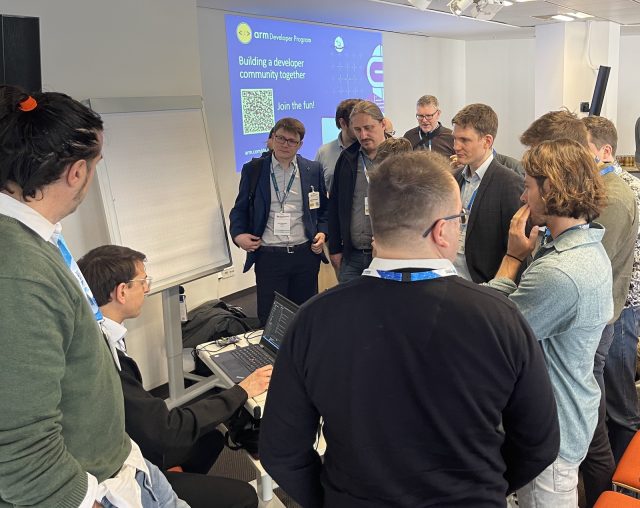
“Now the idea of a demo is not to show kind of the ML performance of it or how accurate the ML performance is,” Yates said. “We’re showing how the system as a whole and the pipeline work and how you can use this Corstone-1000 IP set with a party of partners, and with a machine learning accelerator to get a good IoT hardware IoT solution.”
A software-defined component to the demo demonstrated how developers could leverage Docker containers on various cloud providers, such as AWS, Alibaba or Azure, to develop such a solution.
“With containerizing, you don’t need to build a whole monolithic program,” Yates said. “If you want to update, you can update a single container. If you need to have more performance as well, you can then start some of your containers in the cloud so you can have all your containers on the edge to be more secure.”
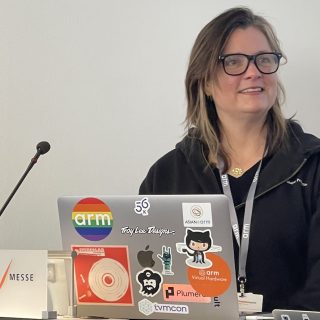
In the end, that unity and cohesion around a future of computing on Arm came down not so much to technology but to the people who see the vision and are making it happen. Mary Bennion, Arm director of ecosystem marketing (above), discussed the Arm Developer Program and celebrated Arm Ambassadors at the breakfast meeting.
“For me, this was an epic event,” Bennion said. “The passion, collaboration, and diverse skill sets of these developers are what truly brings the solutions they build on Arm to life. When these individuals come together, their collective energy and momentum spark innovative ideas and pave the way for our brighter future.”
Asked what’s next, she added, “I can’t wait to see what they’ll do in 2023 and beyond. Come join us!”
Any re-use permitted for informational and non-commercial or personal use only.











